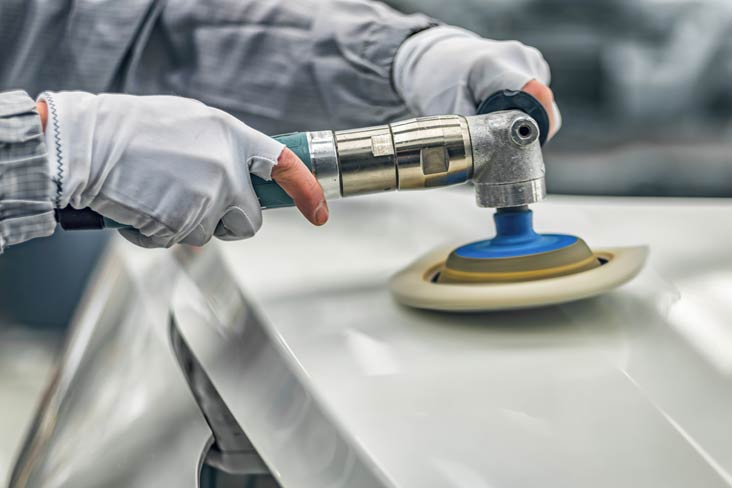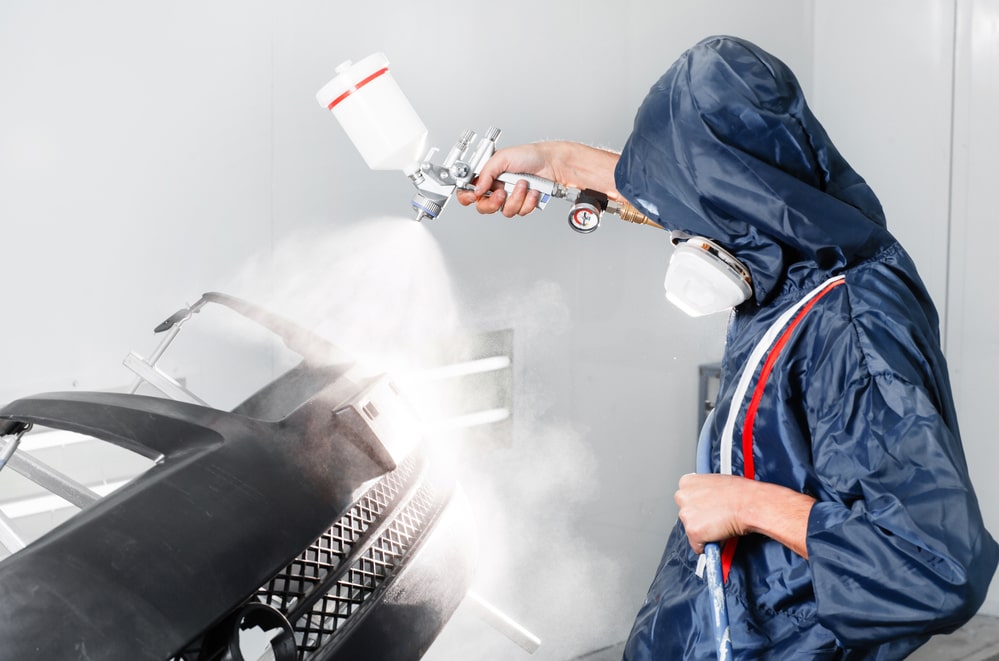Getting the basics of spraying the plastic or how to paint plastic car parts is a great way to improve the fresh appearance of your car and build its unique trademarks. The below step-by-step guide will take you through the steps required to get an accomplished-looking and durable finish using easy-to-interpret methods and cheap rattle cans.
People may have based this guidance on painting bump strips. But the same technique can be applied to any plastic elements, such as interior trim and wing mirror caps. The most important thing needed to get a good result when painting plastic car parts is time and patience. If you have well prepared those two things while following this guide, you will most likely come up with a great-looking finish as desired at the end.
Below are the tools and equipment you will need for a smooth process.
- A designated area for spraying, free of all of the dust and moisture
- Sandpaper graded from 150 grit to 2500 grit. You can use the 2500 grit sandpapers (wet & dry sandpaper) with water for greasing up.
- Painted color
- Plastic primer
- Clear lacquer paint
- A cutting compound or any commercially available scratch remover is acceptable.
- Paint polishing liquid/degradant
- Microfiber car polishing towers/pads or car detailing polish waxing sponge
Contents
Step-by-step Guide On How To Paint Plastic Car Parts
Here are the detailed stages of one plastic parts painting process for your quick reference:
- Preparation
- Primer
- Flatting back primer
- Color coat
- Flatting back color coat
- Clear lacquer
- Finishing – Cutting and polishing
Step 1. Preparation
The first thing to do is remove the parts you wish to paint. Before starting with the primer, it is vital to key the surface of the car part and remove any bubbles which are common on many exterior plastic parts.
The bump strip’s color coding had bobbles on, and from experiences of car polishers, it is necessary to smooth them out using sandpaper. You can begin sanding with 150 grit, then 800 grit, and finish with some 1200 grit sandpaper to get a smooth finish before priming. However, note that sometimes, sandpaper does not seem to work too well on plastics and tends to get gunked up quite quickly, meaning you go through quite a few sheets. Though it can be a bit stressful to take your time through this stage and get a nice smooth surface, you know its role in your finishing paint look.
Aside from parts that have more special treatment, with plastic parts that do not have bobbles on, you still need to clear the surface and remove the shine. If you ignore this act, the car primer will not handle and tolerate properly. And then after 2 or 3 months, the new paint layer will probably trigger and start to flake off or crumble into pieces.

Remember to clean the surface well and get rid of any dust, dirt, and debris that may have accumulated over the years. This act will help the piece look its best. Soaps can contain harsh chemicals that damage paint if left on car parts. It would be better to be safe and clean everything off. Leave them dry in a clean area to avoid getting dusty, and have a cup of tea knowing that your first effort is complete.
Step 2: Priming
Overall, priming is a vital step in every car painting process. Finding a good place to do the priming before painting can be tricky, but the outdoor shacks or garages are all ideal.
Here are a couple of things to consider when priming:
- The importance of cleanliness is always apparent. It is a key part of preserving the environment and ensuring the smoothness of the process. It may be frustrating when you accidentally get dirt or dust on the car paint in the middle of the painting.
- A warm, dry, and low-humidity environment is also perfect for the process to ensure a quick and proper paint layer drying.
- With the weather outside being hard to deal with, the suitable place to get things done is indoors. You can get the same outcome by painting outside, but it will take twice as much paint. And there will be a greater chance of something messing up your car paint.
If you spray on a plastic surface, make sure you have a specialized plastic primer, not a typical one. Please read the instructions on the primer can. Shake it hard for a minute, and make sure the jar is at room temperature too. If the can is cold, it will reduce the pressure, meaning the paint will not spray out as a fine mist.
In addition, if you want to dig deeper into the praying primmer technique to apply the car paint in a smooth layer, check out these notices below:
- Keep the spray or flow nozzle about 5 inches from the about-to-paint plastic car parts.
- Smoothly move the spray throughout the surface of the parts and always keep it in a straight direction.
- When spraying, before you move to other unpainted parts, you should spray until you have completed the previous ones.
It may take some time to discover the optimal spraying speed, giving the best painting outcome. It strikes a balance between the layer of paint being too thin, which may waste paints or take ages, and being too thick, which will risk getting paint runs. Make sure to watch out for the thin edges of the paint layer, as they can easily become too thin and easily peel off. Spraying three to four coats of primer will be enough, and waiting 20 minutes between coats will help ensure each layer dries properly.
When the last priming layer is applied, leave them somewhere warm to dry for a couple of days. You can wait until the solvents have completely evaporated before cleaning. To verify that this is a certified dry part, you can put your noses up to it and take a deep sniff. As antique wisdom has advised, if the paint still smells fresh, then your painting project will require more waits and delays. And after everything is dry and set, get ready to wet sand the surface.
Step 3. Smooth the priming layer
Even if you do everything right, spraying the primer evenly and taking care to prepare the surface, it will somehow still be textured and not smooth. There must be a reason the paint molecules settle and dry the way they do. So to achieve a smooth and polished surface, you need to practice wet sanding.
After wet sanding the area, it should feel smooth to the touch. Now try manipulating some of the sounds you haven’t worked with yet, and see how they feel different. Since it is not easy to tell which areas of the part have been smoothed and which have not, you should only check the smoothing by touch. The water running off the car part will be in a color corresponding to the primer used. If there are still any rough spots on the primer, it will be time to take extra care sanding them smooth. If you want to make sure your woodwork is sanded perfectly, using a flat surface like a sanding block is a good idea.
Once everything is in order, give the car part a quick rinse with cold water to remove any primer residue. If you ignore this only pace in one step, the paint may dry out to dust, and then you will need to wipe it off before applying the coating color.
Step 4. Coat coloring
You now have a smooth, attractive primer base, perfect for applying the next coating color layer. To achieve a flawless result, do the exact coloring-spraying technique described above. Be sure to cover any awkward edges to get the best results. You may be a little annoyed if you go to smooth out the coat, and some of the gray primers are showing their ugly side because the coating car paint was too thin and delicate. A few coats (4 to 5 coats) of color should be enough, and it may take about 20 minutes to dry.

If you want to speed up the process of drying the part effectively, placing it on top of a radiator on low heat can help. In this case, the smell test can help determine when the paint is sufficiently cured to wet sand.
Step 5. Smooth the painted coat
Many people are likely getting impatient with the wait and desire to find a quicker solution for the smooth painted coating. Do not give in to the temptation to cut short your time here. You’ve invested too much time already, and it would be a mistake to mess everything for a few hours. If everything goes according to plan, you should have a good-looking finish by now, and any reflections on that surface will likely be blurry. However, if it is not, there is still some time to fix and make your color coating looks perfect. The next part is about solid colors, not pearlescent or metallic-like surfaces.
To achieve a smooth finish, follow the same steps you used when smoothing the priming layer. A bit of pressure is all needed to achieve the desired outcome. Rinse with gushing water carefully to avoid any potential reaction with varnish. After wet sanding the color coating, there may be a dull matte appearance showing up once it is fully dry. Be patient as this is supposed to happen.
Step 6. Clear the lacquer
At this point, you can use the same spraying technique one more time, but keep in mind that polish or lacquer tends to feel heavier than primer and paint, so be especially careful to avoid streaks. Applying the lacquer will result in the dull finish turning more vibrant, with a beautiful glossy impression.
So how much lacquer should be applied to achieve the desired finish? A coat or two should be enough. Wait for 20 to 30 minutes between coats to allow the paint to dry. Make sure to get good coverage on the edges of your artwork. This will make it look elegant and persuasive.
Step 7. Cut and polish painting layers
Polishing the lacquer before it is completely cured can cause disasters. Many chances are, you may have to wait about a week for your bump strips to dry. Depending on the size and temperature of the part, the process may be prolonged for an unlimited time. To affirm that the lacquer is ready, smell it to see if the solvents are still vaporizing. In case you still can not smell anything, it is best to do that again after one or two days to be secure. Make sure to wait until the lacquer has fully cured before polishing it. This will help keep it looking its best.
This is the final step in the lacquer finish process, where we smooth out any unwanted orange peel and correct any imperfections. If everything goes according to your painting plan, you will already have a beautiful paint coating. With a little bit of effort in cutting and polishing paint, the overall look of your project can be enhanced.
For the cutting process, there is a variety of compounds available on the market, so you can choose the one that yields the best painting results for you. Some people prefer using harsher compounds such as G3, while others might prefer using the Meguiars Scratch X. Both are well-recommended and have pretty high quality.
Start polishing with a small amount of the cutting compound. Apply moderate to strong pressure to focus on small areas at once. Process and decompose the compound. The optical quality of reflections will be improved significantly from the cutting method, and a final polish will give it that perfect mirror finish.
>> See More:
- How To Protect Car Paint: 5 Useful Ways To Follow!
- How Much Paint to Paint a Car? All You Need to Know
Tips For An Effective Process Of Painting Plastic Car Parts
Once you have grasped almost every notice related to the painting plastic car parts method, follow along for more helpful tips on how to paint plastic car parts effectively to the utmost. We did mention some of these tips above but here will be the notices in more detail for your reference. Stay tuned!
It’s necessary to take care of other areas while painting plastic parts to make sure they are not damaged. There are two ways to ensure that your car painting courses do not result in many problems later on. The best option is to remove the parts from the vehicle and paint them separately. As this will minimize the amount of work needed and ensure a high-quality finish. Unfortunately, it may not be possible to cover the painted area completely with some car types. In that case, it is best to use tape to cover the area around the paint. This act will create a barrier between the color paint and the rest of the vehicle, ensuring a clean and successful project.
Prepare the car plastic surfaces before painting
Before painting your car parts made of plastic, take the necessary precautions to ensure a perfect finish. There is a lot of variation in the different types of plastic car parts, so the preparation process will vary depending on the ones you are about to paint. Some of the previous paintwork on these parts will need to be removed to get the new paintwork to stick properly. And if it is badly scratched or dented, you should use a specified filler to smooth out any imperfections.
Regardless of the condition of the part, you should always sand any plastic surface before painting. Sanding can help smooth the car surfaces and bring down many unseen-by-bear-eyes tiny defects, making your project look smoother and more polished. Not only does sanding make the surface of the plastic smoother, but it also creates small crevices that make the plastic more absorbent. The more surface area there is, the more likely the paint will bond to the plastic, resulting in a longer-lasting finish. And after you thoroughly smooth the plastic car parts, make sure to clean them and rinse them clean to get rid of any leftover paint.

Use a plastic promoter adhesive when painting
Most professional auto painters may agree that using plastic adhesion promoters is essential for painting plastic car parts effectively. The promoters contain powerful chemicals that can open the plastic car parts’ pores. Using adhesion promoters will make it easier for new coats of paint to stick to the surface. However, be aware that they should only be used on clean, bare plastic and only if needed. It is ineffective and may even damage the vehicle when applied over primer or combined with any other treatment.
Paint plastic car parts in a clean and ventilated workspace
To achieve the best possible results when painting plastic car parts, set up the project in a well-lit and clean area. Avoid any rooms where dust, particles, or dirt can potentially spin around. The contaminants could cause imperfections in the painting finish, particularly if they adhere to a layer of primer or paint. You should also choose a dry and warm room to ensure a perfect painting experience. As too much humidity could affect the paint drying way, causing it to lose its ability to be well-adhered to the plastic. A warm workspace will help the paint dry at a steady pace, which is crucial for a finished product that looks elegant and persuasive.
Wrapping Up On How To Paint Plastic Car Parts
Indeed, there may be nothing more attractive than a well-maintained vehicle that has recently been painted and is taken to the next level of care. Notice that if you have a plan to paint plastic auto parts, you need to take different precautions compared to painting metal. There are different preparation and product requirements. And if you want to keep your car looking its best as always, spend some time touching up small areas of coating paintwork occasionally.
In short, if you paint plastic auto parts timely and accurately, your paint job will not so soon start to show signs of wear and may last for years to come.
For more car maintenance tips articles like this ‘how to paint plastic car parts’ article, follow Car From Japan today.



